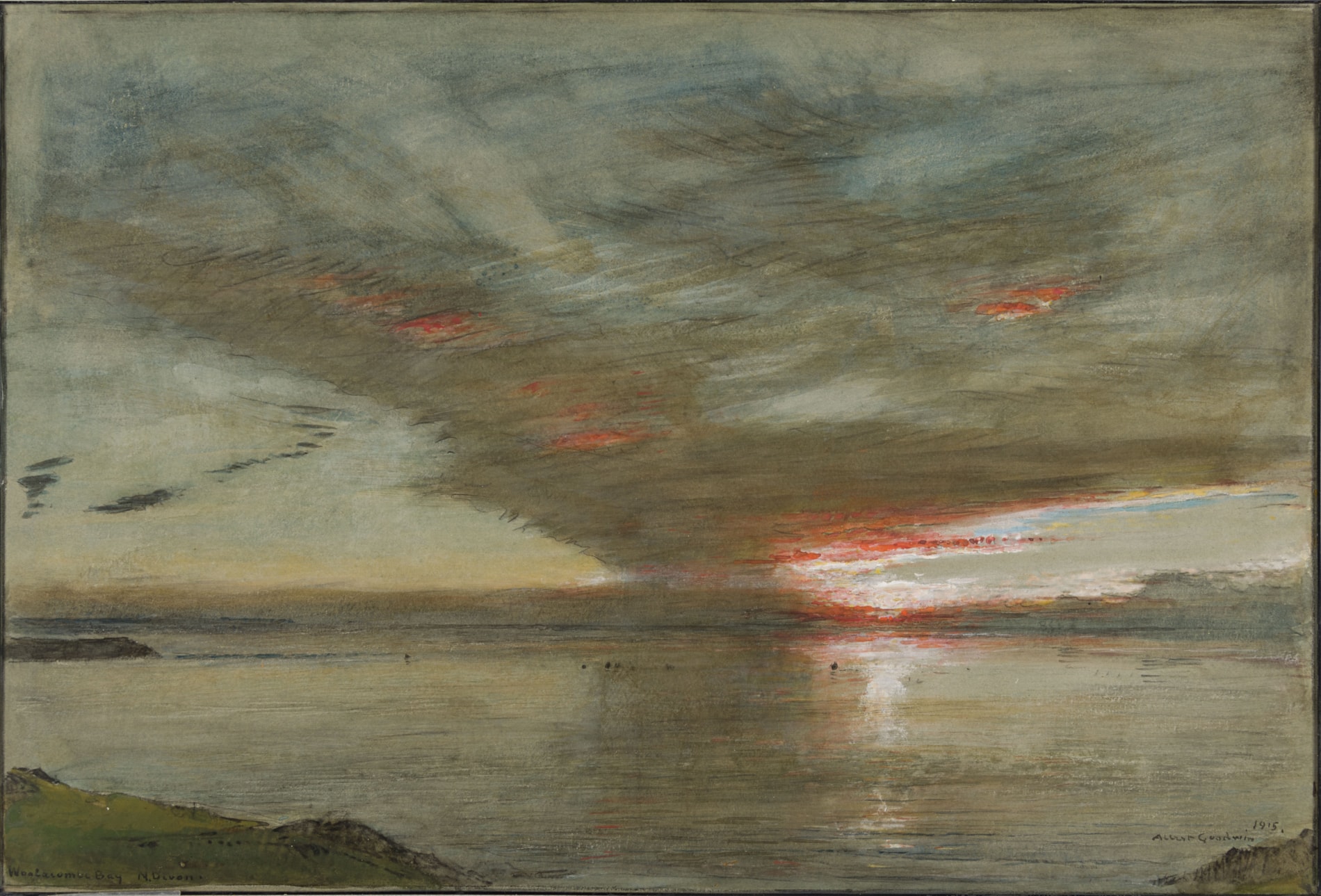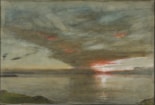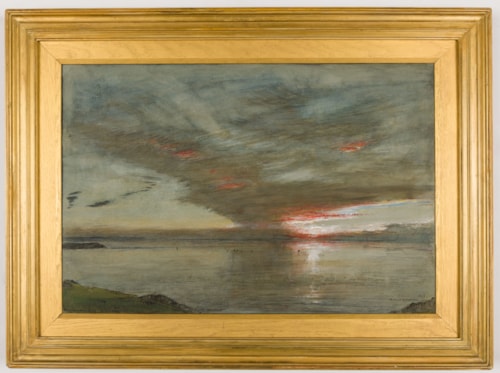Albert GOODWIN
(Maidstone 1845 - Bexhill 1932 )
Sunset at Woolacombe Bay, North Devon
Sold
Watercolour and gouache, over an underdrawing in pencil.
Signed and dated 1915. / ALBERT GOODWIN at the lower right.
Inscribed Woolacombe Bay N. Devon. at the lower left.
355 x 523 mm. (14 x 20 5/8 in.)
Signed and dated 1915. / ALBERT GOODWIN at the lower right.
Inscribed Woolacombe Bay N. Devon. at the lower left.
355 x 523 mm. (14 x 20 5/8 in.)
Albert Goodwin was particularly drawn to sunrises and sunsets. As he noted in another diary entry, from October 1909, ‘I have been thinking how much joy I have had since I was little in the colour of the evening and morning sky and what a delight thousands have in the same thing.’
In 1877 Goodwin settled in the seaside town of Ilfracombe in North Devon, and he maintained close links with the West Country for the remainder of his career. The artist lived in Ilfracombe for more than thirty years, until he moved to Bexhill in Surrey in 1906, although even then he continued to make sketching trips in Devon and Cornwall. He was especially attracted to views of the Atlantic coastline, and in particular at dawn or sunset. As he noted of one of his watercolours, when it was exhibited at the Fine Art Society in 1890, ‘Little is known of the charm of North Devon in winter, where the sun rises all the morning and sets all afternoon.’
Located a few miles to the west of Ilfracombe, the coastal resort of Woolacombe is dominated by a long sandy beach extending over three miles. (During the Second World War Woolacombe Sands served as a training ground for American troops practicing amphibious landings in preparation for the D-Day invasion of Normandy.) In the course of his visit to Woolacombe in the summer of 1915, when this watercolour was drawn, Goodwin appears to have ignored a sign posted on the beach stating that photography or sketching was strictly prohibited, and also despite being warned by a coastguard patrol to the same effect.
In 1877 Goodwin settled in the seaside town of Ilfracombe in North Devon, and he maintained close links with the West Country for the remainder of his career. The artist lived in Ilfracombe for more than thirty years, until he moved to Bexhill in Surrey in 1906, although even then he continued to make sketching trips in Devon and Cornwall. He was especially attracted to views of the Atlantic coastline, and in particular at dawn or sunset. As he noted of one of his watercolours, when it was exhibited at the Fine Art Society in 1890, ‘Little is known of the charm of North Devon in winter, where the sun rises all the morning and sets all afternoon.’
Located a few miles to the west of Ilfracombe, the coastal resort of Woolacombe is dominated by a long sandy beach extending over three miles. (During the Second World War Woolacombe Sands served as a training ground for American troops practicing amphibious landings in preparation for the D-Day invasion of Normandy.) In the course of his visit to Woolacombe in the summer of 1915, when this watercolour was drawn, Goodwin appears to have ignored a sign posted on the beach stating that photography or sketching was strictly prohibited, and also despite being warned by a coastguard patrol to the same effect.
Born in Maidstone in Kent, Albert Goodwin was apprenticed to a draper after leaving school, but soon turned his attention to painting, probably inspired by his friendship with the artist Arthur Hughes, who lived in Maidstone in the 1850s. In 1860, at the age of fifteen, Goodwin had a work accepted at the Royal Academy, and at around the same time was introduced by Hughes to the painter Ford Madox Brown, who became his teacher. Goodwin remained close to Brown for several years, with the latter noting of the young artist, in a letter of 1864, that ‘there can be no doubt of his becoming before long one of the greatest landscape painters of the age.’ The influence of the artists of the Pre-Raphaelite Brotherhood, with which Brown was closely associated, was to have a profound effect on Goodwin’s manner of landscape painting.
The other significant influence on the artist was the prominent art critic, writer and amateur artist John Ruskin, whom he seems to have met around 1869. In 1872 Ruskin invited Goodwin, along with Joan and Arthur Severn, to accompany him on a three-month tour of Switzerland and Italy, a voyage that was to be of lasting significance for the young painter. A highly prolific artist, Goodwin worked productively throughout his long career. He travelled extensively throughout Britain and Europe, as well as further afield; visiting Egypt in 1876, India in 1895, the West Indies in 1902 and 1912, North America in 1912 and New Zealand in 1917. In 1876 Goodwin became an associate member of the Royal Society of Painters in Water-Colours, where he continued to exhibit for over fifty years, and also showed at the Royal Academy between 1860 and 1920. He was the subject of several one-man gallery exhibitions in London, notably eight shows at the Fine Art Society between 1886 and 1907.
Although he often worked in oils, Goodwin is best known as a watercolourist; a medium he seems to have preferred and which accounts for much of his finest work. He was also encouraged in this by Ruskin, who recognized that the watercolour technique allowed the artist to achieve the ephemeral effects and rich tonalities which he came to favour. Towards the end of the century, and for the last thirty years of his career, Goodwin’s watercolours displayed a poetic sense of atmosphere and colour that reflect the increasing inspiration of the late watercolours of J. M. W. Turner, likely through the pervasive influence of Turner’s great champion Ruskin. As Goodwin noted in his diary in 1911, ‘I sometimes wonder if the spirit of old Turner makes use of my personality. I often find (or think I find) myself doing the very things that he seemed to do.’ Like Turner before him, Goodwin often experimented with his watercolour technique, sometimes combining the medium with gouache, pen and ink, chalk, pastel or gum arabic, and occasionally using coloured papers. He also often worked on the surface of the paper itself; as can be seen in a diary entry in March 1912: ‘The two sunsets…I found…far too heavy both in colour and tone – hammered at them with the blade of a safety-razor, a knife, sandpaper, sponge, rag and a fitch brush! So many are the expedients that the despairing watercolour painter in the last has to resort to.’
The other significant influence on the artist was the prominent art critic, writer and amateur artist John Ruskin, whom he seems to have met around 1869. In 1872 Ruskin invited Goodwin, along with Joan and Arthur Severn, to accompany him on a three-month tour of Switzerland and Italy, a voyage that was to be of lasting significance for the young painter. A highly prolific artist, Goodwin worked productively throughout his long career. He travelled extensively throughout Britain and Europe, as well as further afield; visiting Egypt in 1876, India in 1895, the West Indies in 1902 and 1912, North America in 1912 and New Zealand in 1917. In 1876 Goodwin became an associate member of the Royal Society of Painters in Water-Colours, where he continued to exhibit for over fifty years, and also showed at the Royal Academy between 1860 and 1920. He was the subject of several one-man gallery exhibitions in London, notably eight shows at the Fine Art Society between 1886 and 1907.
Although he often worked in oils, Goodwin is best known as a watercolourist; a medium he seems to have preferred and which accounts for much of his finest work. He was also encouraged in this by Ruskin, who recognized that the watercolour technique allowed the artist to achieve the ephemeral effects and rich tonalities which he came to favour. Towards the end of the century, and for the last thirty years of his career, Goodwin’s watercolours displayed a poetic sense of atmosphere and colour that reflect the increasing inspiration of the late watercolours of J. M. W. Turner, likely through the pervasive influence of Turner’s great champion Ruskin. As Goodwin noted in his diary in 1911, ‘I sometimes wonder if the spirit of old Turner makes use of my personality. I often find (or think I find) myself doing the very things that he seemed to do.’ Like Turner before him, Goodwin often experimented with his watercolour technique, sometimes combining the medium with gouache, pen and ink, chalk, pastel or gum arabic, and occasionally using coloured papers. He also often worked on the surface of the paper itself; as can be seen in a diary entry in March 1912: ‘The two sunsets…I found…far too heavy both in colour and tone – hammered at them with the blade of a safety-razor, a knife, sandpaper, sponge, rag and a fitch brush! So many are the expedients that the despairing watercolour painter in the last has to resort to.’
Provenance
Hewson & Forster, Sheffield (their label on the old backing board)
Anonymous sale, Sheffield, Sheffield Auction Gallery, 8 May 2015, lot 672
Maas Gallery, London.
Anonymous sale, Sheffield, Sheffield Auction Gallery, 8 May 2015, lot 672
Maas Gallery, London.





